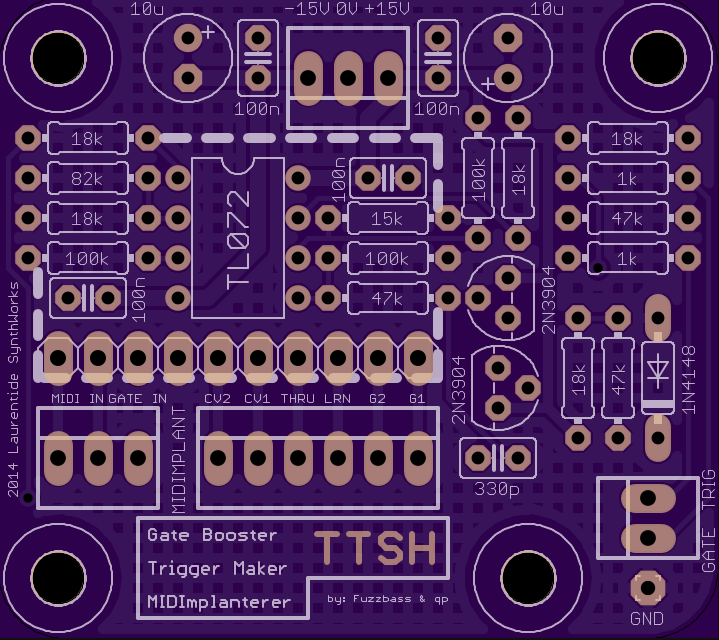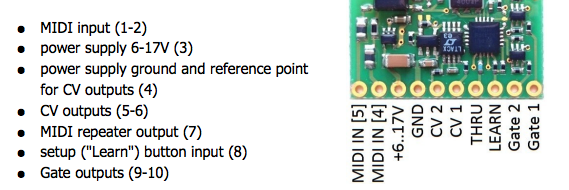what you need:
the Midi device/pcb assembled 50€ plus shipping
http://www.midi-hardware.com/index.php?section=prod_info&product=MIDimplant
1x special gatebooster: around 10€
https://oshpark.com/shared_projects/mYFtCAXo
(ask me, i can organize it)
some pcb headers male/female
Midi connector
cables for wiring around 3m in total (with gatebooster)
4x 18K
1x 82k
2x 1K
3x 100k
3x 47k
1x 15k
2x 10uF electrolyte cap.
2x 100nF MLCC
1x 330pF C0G MLCC Cap.
1x 1N4148
2x 2N3904
Build guide:
1.assemble all parts on the gatebooster, except the headers.
2.solder like shown in my pictures some headers for midiimplant on the gatebooster pcb, i prefer a adapter with male/female headers to remove the midi pcb from gatebooster (for repairs or testing)
3. do the wiring job for the midi connector - mount it in the case - then solder the cables (or you run later in trouble when you try to build in the midi connector in the case - the connector must be built in from front.)
pin 3 and 5 of the midi jack is the signal what you have to connect with the 3 pol header (from left pin 1 and 2 ) on the gatebooster pcb, the third pin is for gate input from TTSH.
4. run a wire from CV1 to the TTSH mainboard pcb header EXT CV IN (no ground needed here)
5. run 3 cables to the GATE/S-H section (AR/ADSR)
the midiimplant gate out must be connected to the Gate jack (switch pin) the Gate jack tip must be connected to Gatebooster input (3pole header right pin)
you have to cut a trace (the trace between gate switch top pin to GATE input)
the gatebooster gate out is connected to the clock switch top left pin, the trigger is connected from gatebooster trigger out to the trigger pcb header (near s/h switch)
<wiring picture later here>
usecase description:
usage of MIDI: the midiimplant creates a 5V Gate signal, this goes thru the gate jack switch to tip pin - this is connected to the gatebooster input, the gatebooster boost the 5V to 10V and create a addional trigger signal,
the boosted gate output is connected to the s/h switch and trigger the ADSR when the Clock switch is selected for GATE, by usage of clock as triggersource (set the clock-gate switch to clock): no signal from gatebooster is feeded in AR/ADSR.
usage of external gate signals:
a external gate (5v) is connected to the gate input, the gate signal from tip pin runs to the gatebooster input, the booster change the 5v to 10v and runs thru the boosteroutput to clock switch (ADSR input) the triggersignal is connected as before to trigger input for AR.
6. for testing/learn function add a pushbutton to midiimplant - wire the pushbutton between ground an LEARN (LRN)
7. power wiring.. on the ttsh mainboard are on each section 6 pcb "holes" this is power, check with a voltmeter for -15v/GND/15v and run cables to the gatebooster power input (near the 10uf electrolyt caps)
DONT run the powerwiring to midiimplant header.
8. approved/tested
further you need to know: by calibration of the TTSH with external CV Input, disconnect the Kbd CV header.
Gallery:
| There are no images attached to this page. |

